
Concept explainers
Name the following

a)
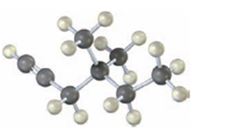
Interpretation:
The alkyne shown is to be named and the products formed when it reacts with 1) H2 in the presence of Lindlar catalyst and 2) H3O+ in the presence of HgSO4 is to be predicted.
Concept introduction:
The longest carbon chain which contains the carbon-carbon triple bond is chosen. The chain is numbered from the end that gives the lowest number to the carbon in triple bond. Compounds with more than one triple bond are called diynes, triynes and so forth. The substituents present, if any are written in the alphabetical order.
When reduced with Hydrogen in the presence of Lindlar catalyst the reduction of alkynes stops in the alkene stage. When treated with H3O+ in the presence of HgSO4, alkynes undergo hydration following Markovnikov regiochemistry to give an enols which will tautomerize to yield aldehydes (terminal alkynes) or ketones (internal alkynes).
To give:
The name of the alkyne shown and to predict the products formed when it reacts with 1) H2 in the presence of Lindlar catalyst and 2) H3O+ in the presence of HgSO4.
Answer to Problem 14VC
The name of the alkyne shown is 4,4-dimethyl-1-hexyne.
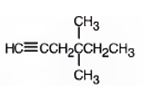
The product formed when it reacts with H2 in the presence of Lindlar catalyst is 4,4-dimethyl-1-hexene.
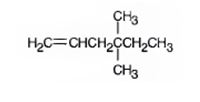
The product formed when it reacts with H3O+ in the presence of HgSO4 is 4,4-dimethyl-2-hexanone.
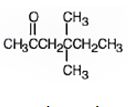
Explanation of Solution
The compound has a six carbon straight chain with two methyl groups on C4 with a triple bond between C1 & C2. Hence it’s name is 4,4-dimethyl-1-hexyne.
When reduced with hydrogen in the presence of Lindlar catalyst, the triple bond becomes a double bond as each of the two carbons in the triple bond gets attached to a hydrogen and an alkene, 4,4-dimethyl-1-hexene,is thus produced.
When treated with H3O+ in the presence of HgSO4, the addition of water takes place in the triple bond following Markovnikov regiochemistry. The OH group adds to more highly substituted carbon and H adds to the less highly substituted carbon in triple bond resulting in the formation of an enol which undergoes tautomerization to yield the ketone, 4,4-dimethyl-2-hexanone.

The name of the alkyne shown is 4,4-dimethyl-1-hexyne.

The product formed when it reacts with H2 in the presence of Lindlar catalyst is 4,4-dimethyl-1-hexene.

The product formed when it reacts with H3O+ in the presence of HgSO4 is 4,4-dimethyl-2-hexanone.

b)

Interpretation:
The alkyne shown is to be named and the products formed when it reacts with 1) H2 in the presence of Lindlar catalyst and 2) H3O+ in the presence of HgSO4 is to be predicted.
Concept introduction:
The longest carbon chain which contains the carbon-carbon triple bond is chosen. The chain is numbered from the end that gives the lowest number to the carbon in triple bond. Compounds with more than one triple bond are called diynes, triynes and so forth. The substituents present, if any are written in the alphabetical order.
When reduced with Hydrogen in the presence of Lindlar catalyst the reduction of alkynes stops in the alkene stage. When treated with H3O+ in the presence of HgSO4, alkynes undergo hydration following Markovnikov regiochemistry to give an enols which will tautomerize to yield aldehydes (terminal alkynes) or ketones (internal alkynes).
To give:
The name of the alkyne shown and to predict the products formed when it reacts with 1) H2 in the presence of Lindlar catalyst and 2) H3O+ in the presence of HgSO4.
Answer to Problem 14VC
The name of the alkyne shown is 2,7-dimethyl-4-octyne.

The product formed when it reacts with H2 in the presence of Lindlar catalyst is cis-2,7-dimethyl-4-octene.
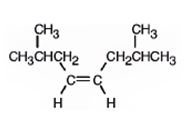
The product formed when it reacts with H3O+ in the presence of HgSO4 is 2,7-dimethyl-4-octanone.

Explanation of Solution
The compound has an eight carbon straight chain with two methyl groups on C2 & C7 with a triple bond between C4 & C5. Hence it’s name is 2,7-dimethyl-4-octyne.
When reduced with hydrogen in the presence of Lindlar catalyst, the triple bond becomes a double bond as each of the two carbons in the triple bond gets attached to a hydrogen and an alkene, cis- 2,7-dimethyl-4-octene.is thus produced.
When treated with H3O+ in the presence of HgSO4, the addition of water takes place in the triple bond. As the alkene is symmetrical the Markovnikov regiochemistry cannot be applied. The OH group adds to one carbon and H adds to the other carbon in triple bond resulting in the formation of an enol which undergoes tautomerization to yield the ketone, 2,7-dimethyl-4-octanone.

The name of the alkyne shown is 2,7-dimethyl-4-octyne.

The product formed when it reacts with H2 in the presence of Lindlar catalyst is cis-2,7-dimethyl-4-octene.

The product formed when it reacts with H3O+ in the presence of HgSO4 is 2,7-dimethyl-4-octanone.

Want to see more full solutions like this?
Chapter 9 Solutions
Organic Chemistry - With Access (Custom)
- The following is a two groups (Regular tomato sauce & Salt Reduced Tomato Sauce) of data recorded by a team analysising salt content in tomato sauce using the MOHR titration method: Regular Tomato Sauce Salt Reduced Tomato Sauce 340.0 262.7 QUESTION: For both groups of data provide answers to the calculations attached in the imagearrow_forward7. Concentration and uncertainty in the estimate of concentration (class data) Class mean for sample (Regular) |[Cl-] (mmol/L) class mean Sn za/2 95% Confidence Interval (mmol/L) [Na+] (mg/100 mL) 95% Confidence Interval (mg/100 mL)arrow_forwardThe following is a two groups (Regular tomato sauce & Salt Reduced Tomato Sauce) of data recorded by a team analysising salt content in tomato sauce using the MOHR titration method: Regular Tomato Sauce Salt Reduced Tomato Sauce 223.4 148.7 353.7 278.2 334.6 268.7 305.6 234.4 340.0 262.7 304.3 283.2 244.7 143.6 QUESTION: For both groups of data calculate the answers attached in the image.arrow_forward
- Give reason(s) for six from the followings [using equations if possible] a. Addition of sodium carbonate to sulfanilic acid in the Methyl Orange preparation. b. What happened if the diazotization reaction gets warmed up by mistake. c. Addition of sodium nitrite in acidified solution in MO preparation through the diazotization d. Using sodium dithionite dihydrate in the second step for Luminol preparation. e. In nitroaniline preparation, addition of the acid mixture (nitric acid and sulfuric acid) to the product of step I. f. What is the main reason of the acylation step in nitroaniline preparation g. Heating under reflux. h. Fusion of an organic compound with sodium. HAND WRITTEN PLEASEarrow_forwardedict the major products of the following organic reaction: u A + ? CN Some important notes: • Draw the major product, or products, of the reaction in the drawing area below. • If there aren't any products, because no reaction will take place, check the box below the drawing area instead. Be sure to use wedge and dash bonds when necessary, for example to distinguish between major products that are enantiomers. Explanation Check Click and drag to start drawing a structure. Х © 2025 McGraw Hill LLC. All Rights Reserved. Te LMUNDARYarrow_forwardSketch the intermediates for A,B,C & D.arrow_forward
- Can the molecule on the right-hand side of this organic reaction be made in good yield from no more than two reactants, in one step, by moderately heating the reactants? O ? A . If your answer is yes, then draw the reactant or reactants in the drawing area below. You can draw the reactants in any arrangement you like. . If your answer is no, check the box under the drawing area instead. Explanation Check Click and drag to start drawing a structure. ㅇ 80 F5 F6 A 2025 McGraw Hill LLC. All Rights Reserved. Terms of Use | Privacy Cente FIGarrow_forwardIn methyl orange preparation, if the reaction started with 0.5 mole of sulfanilic acid to form the diazonium salt of this compound and then it converted to methyl orange [0.2 mole]. If the efficiency of the second step was 50%, Calculate: A. Equation(s) of Methyl Orange synthesis: Diazotization and coupling reactions. B. How much diazonium salt was formed in this reaction? C. The efficiency percentage of the diazotization reaction D. Efficiency percentage of the whole reaction.arrow_forwardHand written equations pleasearrow_forward
- Hand written equations pleasearrow_forward> each pair of substrates below, choose the one that will react faster in a substitution reaction, assuming that: 1. the rate of substitution doesn't depend on nucleophile concentration and 2. the products are a roughly 50/50 mixture of enantiomers. Substrate A Substrate B Faster Rate X Ś CI (Choose one) (Choose one) CI Br Explanation Check Br (Choose one) © 2025 McGraw Hill LLC. All Rights Farrow_forwardNMR spectrum of ethyl acetate has signals whose chemical shifts are indicated below. Which hydrogen or set of hydrogens corresponds to the signal at 4.1 ppm? Select the single best answer. The H O HỌC—C—0—CH, CH, 2 A ethyl acetate H NMR: 1.3 ppm, 2.0 ppm, 4.1 ppm Check OA B OC ch B C Save For Later Submit Ass © 2025 McGraw Hill LLC. All Rights Reserved. Terms of Use | Privacy Center |arrow_forward

 Organic ChemistryChemistryISBN:9781305580350Author:William H. Brown, Brent L. Iverson, Eric Anslyn, Christopher S. FootePublisher:Cengage Learning
Organic ChemistryChemistryISBN:9781305580350Author:William H. Brown, Brent L. Iverson, Eric Anslyn, Christopher S. FootePublisher:Cengage Learning

